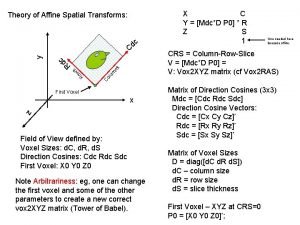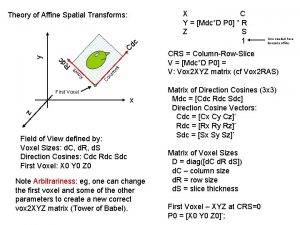ns m lu X C Y MdcD P
![ns m lu X C Y = [Mdc*D P 0] * R Z S ns m lu X C Y = [Mdc*D P 0] * R Z S](https://slidetodoc.com/presentation_image_h2/1b2dbd5f674dea80d8b49079409594bd/image-1.jpg)








- Slides: 9
![ns m lu X C Y MdcD P 0 R Z S ns m lu X C Y = [Mdc*D P 0] * R Z S](https://slidetodoc.com/presentation_image_h2/1b2dbd5f674dea80d8b49079409594bd/image-1.jpg)
ns m lu X C Y = [Mdc*D P 0] * R Z S 1 One needed here because affine. CRS = Column-Row-Slice V = [Mdc*D P 0] = V: Vox 2 XYZ matrix (cf Vox 2 RAS) Co Ro w s R d c y Cd c Theory of Affine Spatial Transforms: First Voxel z x Field of View defined by: Voxel Sizes: d. C, d. R, d. S Direction Cosines: Cdc Rdc Sdc First Voxel: X 0 Y 0 Z 0 Note Arbitrariness: eg, one can change the first voxel and some of the other parameters to create a new correct vox 2 XYZ matrix (Tower of Babel). Matrix of Direction Cosines (3 x 3) Mdc = [Cdc Rdc Sdc] Direction Cosine Vectors: Cdc = [Cx Cy Cz]’ Rdc = [Rx Ry Rz]’ Sdc = [Sx Sy Sz]’ Matrix of Voxel Sizes D = diag([d. C d. R d. S]) d. C – column size d. R = row size d. S = slice thickness First Voxel – XYZ at CRS=0 P 0 = [X 0 Y 0 Z 0]’;

Theory of Affine Spatial Transforms: Two Fields of View within One Coordinate System To map from one Fo. V to the other, need to know the correspondence between the col, row, slice in one Fo. V and the other, ie, given the CRS in Volume 1, what is the CRS in Volume 2? We call this a “vox 2 vox” transform. An example of this problem Is when a functional and structural have been acquired in the same session and the subject has not moved his head. Y Volume 1 X XYZ=V 1*CRS 1 Volume 2 XYZ=V 2*CRS 2 Z XYZ is the same for both, so Note that [inv(V 2)*V 1] and [inv(V 1)*V 2] are “Vox 2 Vox” matrices. XYZ=V 1*CRS 1=V 2*CRS 2 = [inv(V 2)*V 1] * CRS 1 = [inv(V 1)*V 2] * CRS 2

Theory of Affine Spatial Transforms: Two Fields of View, Two Coordinate Systems Y 1 Y 2 Volume 1 XYZ 1=V 1*CRS 1 Z 1 X 1 Z 2 Coordinate Systems are not the same but are linearly related: XYZ 2 = M*XYZ 1 (M is registration) XYZ 1 = V 1*CRS 1 = inv(M)*XYZ 2 X 2 Volume 2 XYZ 2=V 2*CRS 2 Note that [inv(V 1)*inv(M)*V 2] and [inv(V 2)*M*V 1] are Vox 2 Vox matrices. These are NOT arbitrary! BUT, V 1, V 2, V 1*CRS 1 = inv(M)*V 2*CRS 2 and M can change definition without CRS 1 = [inv(V 1)*inv(M)*V 2] * CRS 2 changing the Vox 2 Vox. There is a many CRS 2 = [inv(V 2)*M*V 1] * CRS 2 to one relationship between V 1, V 2, M and the Vox 2 Vox.

Where Does the Vox 2 XYZ matrix come from? Or, equivalently, how is the space defined? How does XYZ relate to RAS? • Scanner Space – coordinate center at magnet isocenter, bore axis is Z, X to the left, Y to the ceiling. Direction cosines and P 0 defined in DICOM file (note: this is an LPS, not RAS coordinate system (assuming subject is Head-First. Supine (HFS)). • Native – basically the same as scanner, but RAS. • Talairach – coordinate center at Anterior Commisure, X to the right, Y points out of the noise, Z points out of the top of the head. This is an RAS space. • RAS – Right-Anterior-Superior (anatomical coordinates). • Field-of-View Based – arbitrarily choose center, directions arbitrary along the index axes. No constraints in relation to RAS. • FSL – center at the corner of the Fo. V • Free. Surfer (tkregister) – center at N/2 • MNI, SPM – use whatever is defined in the file format (eg, QForm/SForm) To get the Scanner Vox 2 XYZ (or Vox 2 RAS): mri_info –vox 2 ras vol. {mgz, mgh, img, nii. gz, bhdr} To get the Free. Surfer/tkregister Vox 2 XYZ (or Vox 2 RAS): mri_info –vox 2 ras-tkr vol. {mgz, mgh, img, nii. gz, bhdr}

Free. Surfer (tkregister) Definitions (needed to interpret register. dat). -1 Cdc = 0 0 0 Rdc = 0 -1 tkreg. Vox 2 XYZ (tkreg. Vox 2 RAS): X -d. C 0 0 +Nc/2 Y= 0 0 +d. S -Ns/2 Z 0 –d. R 0 +Nr/2 0 Sdc = +1 0 +Nc/2 P 0 = -Ns/2 +Nr/2 Voxel Sizes: d. C, d. R, and d. S Field-of-View based – only depends on the identity of columns, rows, and slices, the number of voxels in each dimension, and their sizes. Unrelated to the “true” geometry but is an RAS coordinate system when the volume is “Coronally” sliced, which is the based “conformed” orientation in Free. Surfer. To get the Free. Surfer/tkregister Vox 2 XYZ (or Vox 2 RAS): mri_info –vox 2 ras-tkr vol. {mgz, mgh, img, nii. gz, bhdr} Inside the Free. Surfer C code MRI structure (mri. h): Cdc = [x_r x_a x_s]’, Rdc = [y_r y_a y_s]’, Sdc = [z_r z_a z_s]’ d. C = xsize, d. R = ysize, d. S = zsize P 0 not stored explicitly, rather the XYZ at Ni/2 is stored as c_r c_a c_s Nc = width, Nr = height, Ns = depth

Free. Surfer (tkregister) Definitions – Mapping one volume to another with the register. dat. Contents of register. dat: Subjectname Pixel. Size Slice. Thickness Intensity R 11 R 12 R 13 R 14 R 21 R 22 R 23 R 24 R 31 R 32 R 33 R 34 0 0 0 1 round Functional CRS Tf tk. Reg Vox 2 RAS Matrix for Functional Subject. Name – Free. Surfer Subject ID Pixel. Size – obsolete, can be ignored Slice. Thickness -- obsolete, can be ignored Intensity – only used for display in tkregister 2 Rij – components of the registration matrix round – historical accident, original tkregister performed a “floor” when computing a voxel index. Func Tk. Reg “RAS” register. dat R Vox 2 Vox Anat Tk. Reg “RAS” Ta tk. Reg Vox 2 RAS Matrix for Anatomical orig. mgz CRS Q Vox 2 Vox Matrix: Q=inv(Tf)*R*Ta Func_in_Anat = zeros(Nc, Nr, Ns); for(canat=0; canat<Nc; canat++) // columns in anatomical for(ranat=0; ranat<Nr; ranat++) // rows in anat for(sanat=0; sanat<Ns; sanat++) // slices in anat. CRS[0] = canat; anat. CRS[1] = ranat; … // load into a vector func. CRS = Q*anat. CRS; // compute indices in functional cfunc = round(func. CRS[0]); tfunc = round(func. CRS[1]); … Func_in_Anat[canat][ranat][sanat ]= Func[cfunc][rfunc][sfunc];

Moveable (Free. Surfer) Source (FSL) Input (MINC) Volume A CRS Na Qform Target (Free. Surfer) Reference (FSL) Target (MINC) Vox 2 Vox Q Vol A Native RAS Scanner RAS Ta Vol A Tk. Reg “RAS” Fa Vol A FSL “RAS” CRS = col, row, slice (voxel indices). RAS = right, ant, sup N? – Native or Scanner Vox 2 RAS T? – Tk. Register or Surface Vox 2 RAS F? – FSL Vox 2 RAS X SPM: X=I R M Vol B Native RAS Nb Volume B CRS Qform Scanner RAS Vol B Tk. Reg “RAS” Tb Vol B FSL “RAS” Fb R = Ta*inv(Fa)*inv(M)*Fb*inv(Tb) R = Ta*inv(Na)*inv(X)*Nb*inv(Tb) X = Nb*inv(Tb)*inv(R)*Ta*inv(Na) M = Fb*inv(Tb)*inv(R)*Ta*inv(Fa)

Target (Free. Surfer) Reference (FSL) Target (MINC) MNI 305 Moveable (Free. Surfer) Source (FSL) Input (MINC) orig. mgz Volume A CRS Na Qform Vol A Native RAS Scanner RAS Ta Fa X talairach. xfm Vol A Tk. Reg RAS Surface RAS Vol A FSL RAS N? – Native or Scanner Vox 2 RAS T? – Tk. Register or Surface Vox 2 RAS F? – FSL Vox 2 RAS R M Vol B Native RAS MNI 305 RAS Nb Qform Vol B Tk. Reg RAS Tb Vol B FSL RAS Fb Devolve. XFM(): X 2 = X*Na*inv(Ta) Volume B CRS

Target (Free. Surfer) Reference (FSL) Target (MINC) orig. mgz Moveable (Free. Surfer) Source (FSL) Input (MINC) functional Volume A CRS Na Qform Vol A Native RAS Vol B Native RAS X Nb Volume B CRS Qform Scanner RAS Ta Vol A Tk. Reg RAS R register. dat Vol B Tk. Reg RAS Tb Surface RAS Fa Vol A FSL RAS N? – Native or Scanner Vox 2 RAS T? – Tk. Register or Surface Vox 2 RAS F? – FSL Vox 2 RAS M Vol B FSL RAS Fb R = Ta*inv(Fa)*inv(M)*Fb*inv(Tb) X = Nb*inv(Tb)*inv(R)*Ta*inv(Na) M = Fb*inv(Tb)*inv(R)*Ta*inv(Fa)



